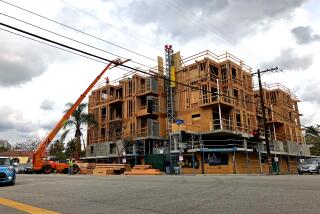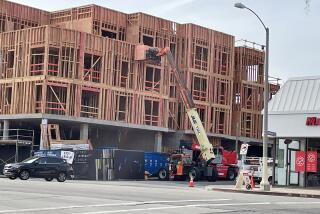Council OKs Curbs on Commercial Land Use : Zoning: Guidelines encourage housing construction in business areas, but development leaders say banks aren’t willing to grant loans for such homes.
- Share via
SANTA MONICA — The Santa Monica City Council voted Tuesday to slash the amount of allowable development on commercial properties by nearly one-third throughout the city and by as much as 50% on large parcels of land.
In addition to curbing commercial development, the new guidelines adopted by the council encourage housing construction within commercial areas. Business leaders predicted that the plan would do little to produce housing because banks are unwilling to lend money for such mixed-use projects.
“The housing incentives are virtually meaningless,” development attorney Chris Harding said after the vote. “No housing will result.”
The 5-1 vote on the new commercial standards broke a stalemate that arose two weeks ago when, for various reasons, five council members voted against approving an environmental impact report that outlines the effects of the new citywide commercial zoning.
Under state law, they had to approve the environmental report before setting the new zoning rules and they were up against a deadline. A moratorium of more than four years on commercial development expires at the end of the month.
Acting City Atty. Joe Lawrence has repeatedly and forcefully cautioned the council against extending the moratorium for another year, saying that it would put the city in an untenable legal position if it were sued.
Something, or someone, had to give or the zoning standards could have reverted to the 1988 rules, meaning that the multiyear effort to overhaul commercial zoning rules, spurred by the city’s slow-growth forces, would have been for naught.
Someone did. Retreating from their positions that the environmental report was fatally flawed, the council’s two most ardent slow-growthers, Ken Genser and Kelly Olsen, voted Tuesday to approve it.
Genser, who had wanted to extend the ban on commercial development and redo the environmental impact report, said he was ultimately persuaded by Lawrence that such a course was unwise.
“I would rather see the downzoning occur,” Genser said. “It’s very clear this will produce benefits for the city.”
Olsen added that spending another $50,000 to redo the environmental impact report would be a lot of money in a year of fiscal crisis.
The 4-2 vote on the report set the stage for the new standards to be adopted on a 5-1 vote. Councilman Paul Rosenstein voted against the environmental impact report but voted in favor of the new zoning standards.
Rosenstein nonetheless criticized the way the final numbers were reached. In a behind-the-scenes political compromise late last month, in which Rosenstein admittedly participated, council members made the zoning standards significantly more stringent--after they had been initially approved and announced to the public.
“It’s an imperfection of the public process to come in after the close of the public hearing and introduce new ideas,” he said.
The changes in the standards were part of an effort to unify Santa Monicans for Renters Rights (SMRR), the fractious tenants rights alliance that dominates city politics, and accommodate Genser and Olsen.
The deal was unveiled in the June 1 meeting, angering the two council members not affiliated with SMRR and members of the business community who said that the council was reneging on an earlier decision as a way to achieve political peace within the tenants rights group.
Councilman Robert T. Holbrook said he voted against the standards in protest of their being altered after the close of the public process.
“I think it’s a betrayal to our public,” Holbrook said in an interview. “The council bent to the political pressures of Santa Monicans for Renters Rights, who really want to put this issue behind them.”
But Mayor Judy Abdo rejected all efforts to characterize the process as being flawed or resulting from back-room dealing, insisting that there was nothing unusual about reopening negotiations after the standards were set.
“I think it’s our job to see what’s come before us, hear what the public said and make changes, if appropriate,” Abdo said.
After the meeting, Abdo said she thinks that the new rules will help bring more housing to the city, if not immediately, then as the idea of mixed-use takes hold in the country.
Genser, her partner in the overall compromise, is not so convinced, saying bluntly at the meeting that he didn’t expect to see new housing.
Housing is a key issue because the state is pressuring the city to create more housing. But options are limited. Politically, the council majority is obliged to protect existing rental housing properties from redevelopment because redevelopment would free those properties from rent control.
Attorney Harding accused some council members of cynically using housing incentives as a tool to block development. He contended that the council majority’s real agenda mirrored that of other exclusionary communities in the state, such as Rolling Hills and Palos Verdes Estates, which severely restrict commercial development.
“In Santa Monica, the leadership is reactionary masking as progressive,” Harding said.
More to Read
Sign up for Essential California
The most important California stories and recommendations in your inbox every morning.
You may occasionally receive promotional content from the Los Angeles Times.









